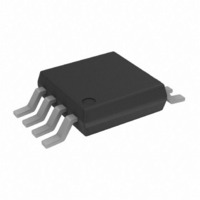AD7911ARMZ Analog Devices Inc, AD7911ARMZ Datasheet - Page 21

AD7911ARMZ
Manufacturer Part Number
AD7911ARMZ
Description
IC ADC 10BIT DUAL 2CH 8-MSOP
Manufacturer
Analog Devices Inc
Datasheet
1.AD7921ARM-REEL7.pdf
(28 pages)
Specifications of AD7911ARMZ
Data Interface
DSP, MICROWIRE™, QSPI™, Serial, SPI™
Operating Temperature
-40°C ~ 85°C
Number Of Bits
10
Sampling Rate (per Second)
250k
Number Of Converters
1
Power Dissipation (max)
20mW
Voltage Supply Source
Single Supply
Mounting Type
Surface Mount
Package / Case
8-TSSOP, 8-MSOP (0.118", 3.00mm Width)
Resolution (bits)
10bit
Input Channel Type
Single Ended
Supply Voltage Range - Analogue
2.35V To 5.25V
Supply Current
4mA
No. Of Pins
8
Sampling Rate
250kSPS
Rohs Compliant
Yes
Number Of Elements
1
Resolution
10Bit
Architecture
SAR
Sample Rate
250KSPS
Input Polarity
Unipolar
Input Type
Voltage
Rated Input Volt
5.25V
Differential Input
No
Power Supply Requirement
Single
Single Supply Voltage (typ)
3/5V
Single Supply Voltage (min)
2.35V
Single Supply Voltage (max)
5.25V
Dual Supply Voltage (typ)
Not RequiredV
Dual Supply Voltage (min)
Not RequiredV
Dual Supply Voltage (max)
Not RequiredV
Power Dissipation
20mW
Differential Linearity Error
±0.5LSB
Integral Nonlinearity Error
±0.5LSB
Operating Temp Range
-40C to 85C
Operating Temperature Classification
Industrial
Mounting
Surface Mount
Pin Count
8
Package Type
MSOP
Input Signal Type
Single-Ended
Lead Free Status / RoHS Status
Lead free / RoHS Compliant
Lead Free Status / RoHS Status
Lead free / RoHS Compliant
Available stocks
Company
Part Number
Manufacturer
Quantity
Price
Company:
Part Number:
AD7911ARMZ
Manufacturer:
ADI
Quantity:
3 000
Part Number:
AD7911ARMZ
Manufacturer:
ADI/亚德诺
Quantity:
20 000
Company:
Part Number:
AD7911ARMZ-REEL
Manufacturer:
ADI
Quantity:
3 000
Company:
Part Number:
AD7911ARMZ-REEL7
Manufacturer:
ADI
Quantity:
3 000
SERIAL INTERFACE
Figure 30 and Figure 31 show the detailed timing diagrams for
serial interfacing to the AD7921 and AD7911, respectively. The
serial clock provides the conversion clock and also controls the
transfer of information from the AD7911/AD7921 during
conversion.
The CS signal initiates the data transfer and conversion process.
The falling edge of CS puts the track-and-hold into hold mode,
takes the bus out of three-state, the analog input is sampled at
this point, and the conversion is initiated.
For the AD7921, the conversion requires 16 SCLK cycles to
complete. Once 13 SCLK falling edges have elapsed, the track-
and-hold goes back into track on the next SCLK rising edge, as
shown in Figure 30 at Point B. On the 16th SCLK falling edge,
the DOUT line goes back into three-state. If the rising edge of
CS occurs before 16 SCLKs have elapsed, then the conversion is
terminated and the DOUT line goes back into three-state.
Otherwise, DOUT returns to three-state on the 16th SCLK
falling edge, as shown in Figure 30. Sixteen serial clock cycles
are required to perform the conversion process and to access
data from the AD7921.
For the AD7911, the conversion requires 14 SCLK cycles to
complete. Once 13 SCLK falling edges have elapsed, the track-
and-hold goes back into track on the next SCLK rising edge, as
shown in Figure 31 at Point B.
DOUT
DOUT
SCLK
SCLK
DIN
DIN
CS
CS
THREE-STATE
THREE-STATE
t
t
2
2
X
X
Z
Z
1
1
t
ZERO
t
ZERO
3
3
X
X
2
2
CHN
CHN
t
t
CHN
CHN
8
8
3
3
X
X
t
Figure 30. AD7921 Serial Interface Timing Diagram
Figure 31. AD7911 Serial Interface Timing Diagram
CONVERT
X
X
t
t
4
9
4
9
DB11
DB9
t
t
t
t
6
6
4
4
t
X
X
CONVERT
5
5
t
t
DB10
7
7
DB8
Rev. 0 | Page 21 of 28
X
X
13
13
If the rising edge of CS occurs before 14 SCLKs have elapsed,
then the conversion is terminated and the DOUT line goes back
into three-state. If 16 SCLKs are considered in the cycle, DOUT
returns to three-state on the 16th SCLK falling edge, as shown
in Figure 31.
CS going low clocks out the first leading zero to be read in by
the microcontroller or DSP. The remaining data is then clocked
out by subsequent SCLK falling edges beginning with the
second leading zero. Therefore, the first falling clock edge on
the serial clock has the first leading zero provided and also
clocks out the second leading zero. The final bit in the data
transfer is valid on the 16th falling edge, having been clocked
out on the previous (15th) falling edge.
In applications with a slower SCLK, it is possible to read in data
on each SCLK rising edge. In that case, the first falling edge of
SCLK clocks out the second leading zero and it can be read in
the first rising edge. However, the first leading zero that is
clocked out when CS goes low is missed, unless it is not read in
the first falling edge. The 15th falling edge of SCLK clocks out
the last bit and it can be read in the 15th rising SCLK edge.
If CS goes low just after the SCLK falling edge has elapsed, CS
clocks out the first leading zero as before and it can be read in
the SCLK rising edge. The next SCLK falling edge clocks out
the second leading zero and it can be read in the following
rising edge.
DB2
DB0
B
B
TWO TRAILING ZEROS
X
X
14
14
t
t
5
5
ZERO
DB1
X
X
15
15
ZERO
DB0
X
X
16
THREE-STATE
16
THREE-STATE
t
t
10
10
t
t
QUIET
QUIET
t
t
1
1
AD7911/AD7921











